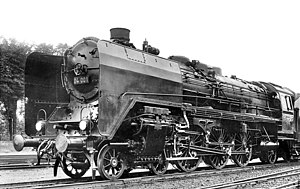DR series 04
| DR series 04 / 02.1 | |
|---|---|
| Numbering: | 04 001–002 or 02 101–102 |
| Number: | 2 |
| Manufacturer: | Croup |
| Year of construction (s): | 1932 |
| Retirement: | 1939 |
| Axis formula : | 2'C1 'h4v |
| Genre : | S 36.18 |
| Gauge : | 1435 mm ( standard gauge ) |
| Length over buffers: | 23,905 mm |
| Height: | 4250 mm |
| Total wheelbase: | 12,000 mm |
| Wheelbase with tender: | 20,225 mm |
| Empty mass: | 97.25 t |
| Service mass: | 106.3 t |
| Friction mass: | 59.5 t |
| Wheel set mass : | 18.79 t |
| Top speed: | 130 km / h |
| Indexed performance : | 1545 kW - 1706 kW (depending on the state of construction) |
| Driving wheel diameter: | 2000 mm |
| Impeller diameter front: | 1000 mm |
| Rear wheel diameter: | 1250 mm |
| Control type : | Heusinger with hanging iron |
| Number of cylinders: | 4th |
| HD cylinder diameter: | 350 mm |
| LP cylinder diameter: | 520 mm |
| Piston stroke: | 660 mm |
| Boiler overpressure: | 25 bar |
| Number of heating pipes: | 84 (04 001) / 75 (04 002) |
| Number of smoke tubes: | 38 (04 001) / 24 (04 002) |
| Heating pipe length: | 5,800 mm (04 001) 6,800 mm (04 002) |
| Grate area: | 4.10 m² |
| Radiant heating surface: | 20.0 m² |
| Superheater area : | 88.0 m² (04 001) 84.6 m² (04 002) |
| Evaporation heating surface: | 188.6 m² |
| Tender: | 2'2 'T32 |
| Water supply: | 32.0 m³ |
| Fuel supply: | 10 t |
The two steam locomotives of the class 04 were medium-pressure test locomotives of the Deutsche Reichsbahn , which were derived from the standard steam locomotives of the class 03 .
history
In 1932, the Deutsche Reichsbahn attempted to increase the boiler pressure from 16 atü (15.7 bar) to 25 atü (24.5 bar) by using high-strength steels . The machines built by the Krupp company were first examined at the LVA Grunewald . With a specific steam consumption value of 5.2 kg / PSh in relation to the indicated power, the locomotives clearly fell short of the already quite low steam consumption value of the 03 series by over 1 kg / PSh. The coal consumption based on the effective power on the towing hook was 0.96 kg / PSh compared to 1.13 kg / PSh on the 03. The medium-pressure boilers did not prove to be stable, and damage to the fire box occurred after a short time . Since the locomotives did not meet expectations even after modifications and repairs, the permissible boiler overpressure was finally lowered to 20 atmospheres in 1935 and they were added to the fleet with the company numbers 02 101 and 02 102. They were then supposed to be used in regular train service from the Hamburg-Altona depot, but since they had no experience with four-cylinder compound locomotives there, they were handed over to the Hof depot in 1936 . Due to a lack of water, the boiler of the 02 101 exploded on April 3, 1939; then both machines were scrapped; In 1940 they were finally scrapped.
The standard locomotives were coupled with standard tenders of type 2'2 'T32.
literature
- Weisbrod / Müller / Petznick: Railway vehicle archive, steam locomotives of German railways, series 01 - 39 . 3. Edition. Alba (Transpress), Düsseldorf (Berlin) 1978, ISBN 3-87094-081-6 .
- Horst J. Obermayer, Manfred Weisbrod: Locomotive Archive, Steam Locomotive Report, Class 01-19 (Eisenbahn-Journal-Archiv 94/01) . 1st edition. Hermann Merker Verlag, Fürstenfeldbruck 1993, ISBN 3-922404-40-5 .
Individual evidence
- ^ Author collective Johannes Schwarze, Werner Deinert, Lothar Frase, Heinz Lange, Oskar Schmidt, Georg Thumstädter, Max Wilke: Die Dampflokomotive. Development, construction, mode of operation, operation and maintenance as well as locomotive damage and its elimination . Reprint of the 2nd edition from 1965 by Transpress Verlag, Stuttgart 1998, ISBN 3-344-70791-4 , table in Appendix 1.1
- ↑ http://www.albert-gieseler.de/dampf_de/lokdaten15/lokdet154319.shtml
